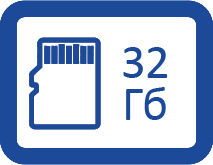 |
Video camera matrix size |
The size of the photosensitive matrix of the camera in inches. |
 |
Infrared illumination |
Infrared lighting is necessary for video recording in low-light conditions, such as at night or at dusk. When the infrared illumination is activated, the image is switched to black-and-white shooting mode. |
 |
Video recording resolution |
Recording resolution in megapixels affects image detail and quality. The higher the number of megapixels, the more detailed the image will be. |
 |
Dust and moisture protection |
The index of protection of the equipment against penetration of dust and moisture into the middle of the case. The higher the rating numbers, the more protected the equipment is from the effects of atmospheric precipitation. |
 |
Hard disk support |
The mark informs that the device supports work with an external hard disk. For example, video recorders can record on one or more hard drives. |
 |
Memory card support |
The mark informs that the device has a slot for memory cards for local video recording. Most video surveillance cameras support memory cards from 32 to 256 GB and above. |
 |
Support for 10th class memory cards |
Class 10 memory cards have a minimum recording speed of 10 MB/s, for example, for recording videos in high FullHD resolution. |
 |
The speed of writing / reading |
The mark informs about the speed of writing and reading video and audio to/from a memory card or hard disk. |
 |
Deep learning algorithm |
The device supports video analytics functions and deep learning algorithms, such as face or license plate recognition. |
 |
Power supply |
Operation from a 220 V power source. |
 |
Autonomous work |
Battery or built-in battery runtime. |
 |
RS-485 |
RS-485 interface support. |
 |
HDMI |
Support for HDMI multimedia data transfer interface. |
 |
Number of channels |
Number of channels supported. |
 |
Cloud storage |
Support for remote cloud storage. |
 |
RAID-array |
Support for storage in a RAID array of independent disks. |







